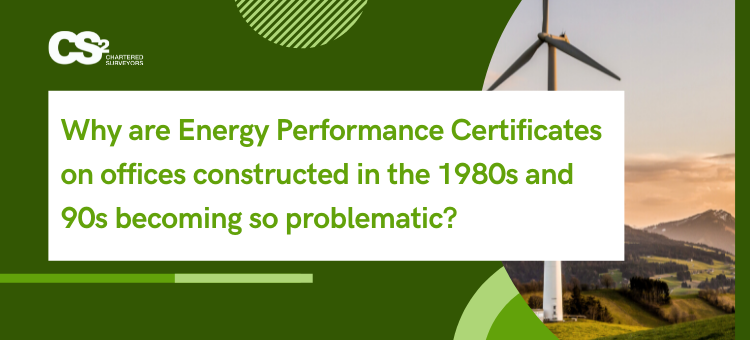Why are Energy Performance Certificates on offices constructed in the 1980s and 90s becoming so problematic?
- December 1, 2021
- 1,407 views

Since the onset of the MEES (Minimum Energy Efficiency Standard) Regulations (2015) in April 2018, commercial EPC’s on certain building types are becoming more problematic – slowly! One such area is offices constructed from 1980 to 2005, with centralised HVAC systems, such as Constant and Variable Air Volume, even Fan Coil Units. Effectively as these buildings were constructed with differing degrees of thermal integrity, often with features such as external solar shading, solutions like Variable Speed Drives and LED or T5 have been retrofitted….yet the EPC comes back as a G.
Potentially compounding the problem is the consultation paper to central government outline the following proposed dates and standards:
First Compliance Window: EPC C (2025-2027)
- 1 April 2025: Landlords of all non-domestic rented buildings in scope of MEES must present a valid EPC.
- 1 April 2027: All non-domestic rented buildings must have improved the building to an EPC ≥ C, or register a valid exemption.
Second Compliance Window: EPC B (2028 – 2030)
- 1 April 2028: Landlords of all non-domestic rented buildings in scope of MEES must present a valid EPC.
- 1 April 2030: All non-domestic rented buildings must have improved the building to an EPC ≥ B, or register a valid exemption.
If the latter comes into play in its full capacity, the expenditure to ensure our assets are compliant will be significant on an office constructed 20-40 years ago and early to mid-life cycle.
The answer lies in the BRE’s balancing within the National Calculation Methodology certain combinations of building type and HVAC use drive low ratings…. if the seasonal efficiencies of boilers and condensers cannot be found the EPC software reverts back to low defaults creating a rating that will not allow a lease to be signed or a sale to complete. Therefore impacting the Asset Value and Rentable Rates. Some of the issues being that manufacturers did not historically have to document this information and post-construction any detailed schematics are often long gone. Increasingly engineers are generating cost proposals to rectify the situation, the rule of thumb is to replace the existing centralised system with VRF systems – with a million-pound price tag and no solution on how to recapture the investment via rentable values.
As we progress down the Net Carbon Zero route and various reporting elements come into play, not just EPCs but Scopes 1,2 and 3 and GHG Protocol, it is forcing the premature replacement of seemingly efficient HVAC systems. This is to satisfy the EPC conundrum and pander to the Natural Gas Phaseout. The result is a capex investment over the coming years, however, this needs to be targeted and weighted up – not just in terms of today’s solution, but also what will satisfy future regulations and meet tenants net-zero aspirations.
CS2 are working with funds and asset managers to formulate 10-year Net Zero Carbon and ESG plans for their portfolios; for more information please contact CS2’s Energy and Sustainability Consultant, James Cutter.



0 Comments